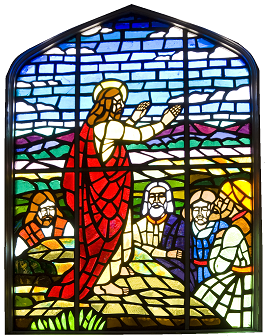A work called here, Matthew’s Message, lies behind the Gospel of Matthew, and provided most of its content. The Gospel of Matthew consists of this work plus a large part of the Gospel of Mark, and some minor editorial changes made when finally published.
The Gospel of Matthew does not explicitly identify its author: the identification of the author as Matthew comes from its title. Since there are no variations in this title, despite the widespread distribution of this work, we can conclude that this title was attached from the very first time the Gospel of Matthew was copied with the purpose of being widely distributed. Furthermore, the attribution of the whole work to Matthew indicates that, at least, he was the author of the most substantial part of this work. Yet about a third of the Gospel of Matthew can be seen to been drawn word-for-word from the Gospel of Mark. This leaves about two-thirds of the Gospel of Mark likely to have been drawn from a work that I call Matthew’s Message, being a work that can be reasonably attributed to the Matthew, the disciple of Jesus, and one of the twelve apostles. On this basis we can perceive that there were two authors of the Gospel of Matthew: Matthew himself, the originator of most of the text, and someone I call Matthew’s Editor, who produced the final form of the original text of the Gospel of Matthew.
Matthew’s Message is manifestly a single composition, constructed with a single consistent plan and purpose, and written from a definable point of view. It was written with a Jewish audience in mind. As Matthew perceived it, the way of life for the Christian was one in which the Jewish way of life continued to play a central role. Indeed, it remains undisputed that the twelve initially expected that those drawn from the nations would conform themselves to Jewish norms (at least as interpreted by Jesus). The twelve conformed themselves to these norms, in particular circumcision and food laws, and therefore they would have expected those they made disciples to conform themselves to these as well. In this context, it is also relevant that Matthew’s Message shows that Jesus taught his disciples to respect the Law as well as commanding them to teach the nations everything he had taught them.
It is clear from the text of Matthew’s Message that it was written before the Council of Jerusalem. This work shows no sign that it was written in the light of the controversy over the great inflow of non-Jews into the Christian community. That controversy was resolved, at least for the leadership, by the Council of Jerusalem, around AD 51. Yet when we examine Matthew’s Message we cannot see a single backwards-looking reflection on Jesus’ teachings in the light of the Council’s decision. On this basis, a date for Matthew’s Message of just before the Council of Jerusalem, around AD 50, is the most likely option.
As a parallel argument, we can note that Paul’s letter to the Galatians shows no signs that the Christians there had been introduced to Matthew’s Message. From this, we can reasonably conclude that Matthew’s Message was not written before the missionary journey of Paul and Barnabas, which took them to (southern) Galatia. This means that the earliest date for the composition of Matthew’s Message can be set sometime after they began that first formal missionary journey and before Paul’s subsequent missionary journeys. On this basis, also, the date of the composition of Matthew’s Message can be set as ca. 50.
On the other hand, we can conclude that Matthew’s Message was already written when Paul began his second missionary journey, and before Paul and Silvanus established the first church in the city of Thessalonica. For example, in his letter to them, sent from Corinth, Paul cites as the “word of the Lord†a prophecy of Christ’s future descent from heaven to earth (1 Thess. 4:15-17,). This prophecy can be found in the text of Matthew’s Message. His later letters can also be seen to have written by someone who had been immersed in the teachings of Matthew’s Message, and had made that work an integral part of his own understanding of the Gospel.
In summary, it is fair to conclude that Matthew’s Message was an early work, written by Matthew the Apostle, and represents the earliest (surviving) written account of Jesus’ teachings, being embedded in the Gospel of Matthew.

